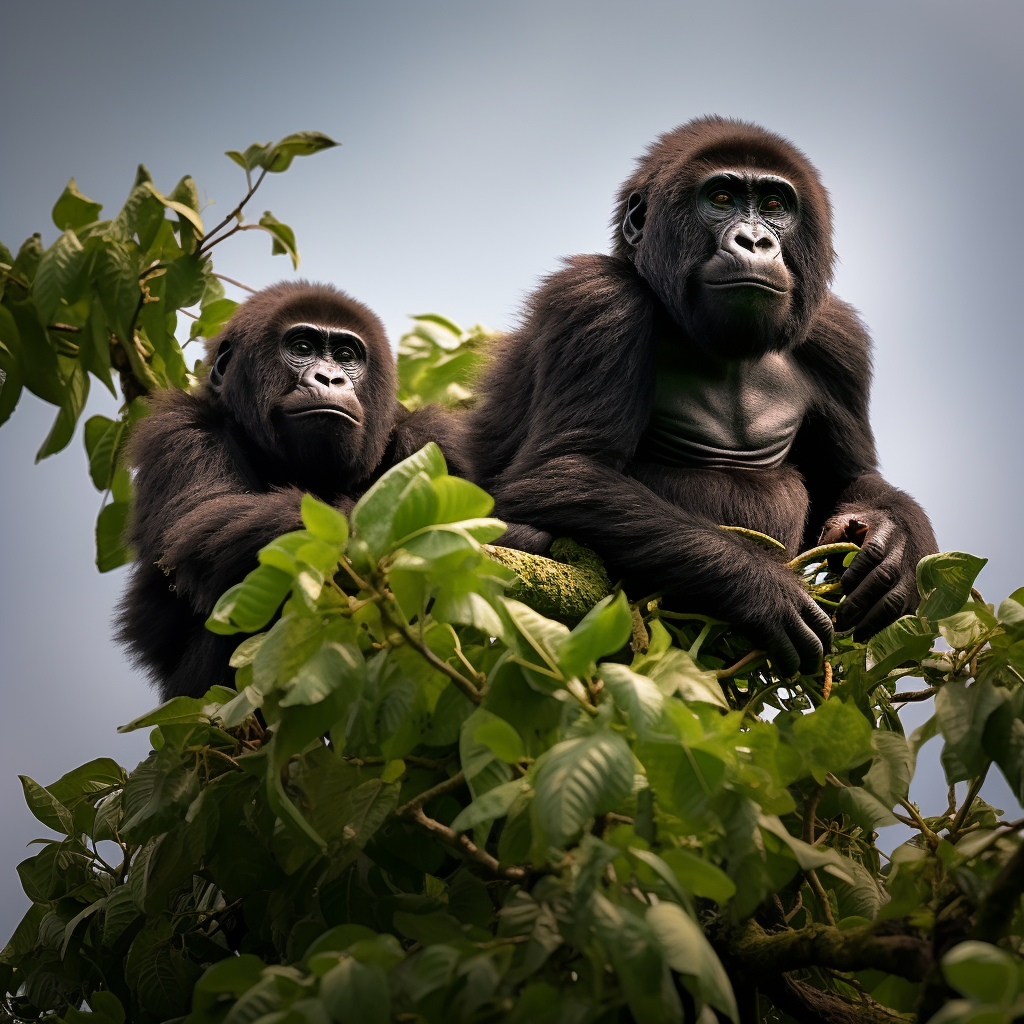Takeaways
- 1. Gorillas grow at a relatively slow rate compared to other primates, taking several years to reach their full adult size.
- 2. The growth rate of gorillas varies depending on their sex and species. Male gorillas tend to grow faster and larger than females.
- 3. Gorilla growth is influenced by various factors, including genetics, nutrition, and environmental conditions.
- 4. The first few years of a gorilla’s life are crucial for its growth and development. Adequate nutrition during this period is essential for their overall health.
- 5. Gorillas experience a growth spurt during their adolescent years, where they gain significant size and strength.
- 6. The growth rate of gorillas can be affected by factors such as habitat loss, poaching, and disease, which can impact their access to food and overall well-being.
- 7. Understanding the growth patterns of gorillas is important for conservation efforts and ensuring their long-term survival in the wild.
- 8. Research on gorilla growth can provide valuable insights into primate development and evolution, as well as contribute to our understanding of human growth and development.
Growin’ up as a gorilla is an exciting journey – packed with special experiences and challenges. From newborns to adulthood, these incredible creatures go through many stages that shape their lives. So, how does a gorilla grow? Let’s dive into the details of this amazing process.
Gorillas have wild transformations from the moment they’re born. As babies, they are super dependent on their mama for food, protection, and direction. These early years are vital for their survival and growth. Young gorillas learn essential skills such as climbin’ trees, socializin’ with their troop, and explorin’ their natural habitat.
As they enter adolescence, they start showin’ signs of independence and curiosity. This time is marked by a enthusiasm to investigate their environment and connect more actively with the others in the troop. They play games to help them improve their physical abilities and sharpen their mental skills.
Movin’ into adulthood, gorillas set up their own identities within the troop hierarchy. Males become dominant while females are caring caregivers to the young ones. This stage is important for reproducin’ success, as males compete for mating rights and females raise babies to keep their species goin’.
To help gorillas with their growing journey, there are a few things we can do. First, supporting conservation efforts is key to preserving their natural habitat and creating a sustainable future for these magnificent creatures. Also, educating local communities about living peacefully with gorillas reduces human-animal conflict. This can be done with awareness campaigns to show the role gorillas have in keeping the ecosystem in balance, and the economic advantages of responsible ecotourism centered around observing those awe-inspiring animals.
Physical Development of Gorillas
.jpg)
Gorillas grow in physical development, just like humans. From the moment they are born until adulthood, remarkable changes take place in their bodies. Baby gorillas are small and fragile compared to adults. As they age, their size and strength increase.
Infants rely on their mothers for care and protection. Nursing continues for a few months before they move onto solid foods. As toddlers, their muscles strengthen through play. Climbing trees also helps them become agile and dexterous.
Adolescent male gorillas begin to mature. They have broader shoulders and more prominent facial features. Plus, their body mass increases significantly and they become powerful figures in their social groups.
Genetics and environment impact gorilla physical development. Different subspecies can have distinct characteristics based on things like diet and habitat. This variety adds even more detail when learning about these amazing creatures.
In conclusion, the physical development of gorillas is a complex process. From helpless infants to powerful adults, they transform over time. Knowing more about their development allows us to better understand and appreciate nature.
Social Development of Gorillas

Gorillas, like us humans, go through a social development process as they grow up. Let’s explore this interesting part of their lives!
- Gorillas are highly social animals who live in groups known as troops. This troop is composed of one main male (silverback), some females and their babies.
- Social interactions play an important role in the development of gorillas. Young gorillas learn essential skills by observing and copying the behavior of older members in their troop.
- As they mature, young gorillas start forming relationships within the troop. They form bonds, engage in play to strengthen these links and establish their place in the social order.
Gorillas use vocalizations, gestures and body postures to communicate. This lets them express their feelings, keep the group together and show dominance without using violence.
A cool fact about gorilla socialization is that when born, infants rely completely on their mothers for protection and care. They are held on their mother’s belly or back until they are about four months old (source: National Geographic).
Watch out for those bananas – they’re not just for climbing trees. They are the key to gorilla muscular physique too!
Diet and Nutrition during Gorilla Growth
Gorillas need specific diets to grow and develop. Their diet mainly consists of vegetation like leaves, stems, fruits, and tree bark. Let’s take a peek at diet and nutrition for gorilla growth.
| Food Type | Examples |
|---|---|
| Vegetation | Leaves, stems, fruits, bark |
| Protein | Insects, small vertebrates |
| Supplements | Minerals, vitamins |
Gorillas consume lots of vegetation for energy. They also eat insects and sometimes small vertebrates for protein. To stay healthy, gorillas sometimes need minerals and vitamins as supplements.
Gorillas forage for food in their natural habitat. They use both hands and feet to quickly gather foliage. This helps them get the nutrients they need for growth and development.
Scientists have studied gorilla diets for decades. They’ve studied gorilla diets to learn more about their nutritional needs during growth. This research has shown the importance of a varied diet full of vegetation for healthy gorilla development.
Gorillas start off playful and end up powerful. Their behavior changes from ‘pass me the bananas’ to ‘I could crush you like a grape.’ It’s an amazing evolution of strength and sophistication.
Behavioral Changes and Maturity

Gorillas have remarkable changes in behavior as they mature – from playful juveniles to independent adults. Let’s explore these fascinating developments!
Before maturity:
- Active + playful
- Dependent on mothers
- Rough play with peers
- Exploration + curiosity
After maturity:
- Calm + composed
- Self-sufficient in finding food
- Dominance through chest-beating + vocalizations
- Protection of family group
Before maturity, gorillas are active, playful and dependent on their mums. But when they mature, they become calmer, more independent and proficient in finding food. Youngsters engage in rough play with their peers to practice social skills and establish hierarchy. When they reach maturity, males show dominance through chest-beating and vocalizing, while females are nurturing.
To understand better gorilla maturation, we must recognize the unique details of each stage. From curious explorers to family protectors, gorillas show the intricate nature of growth in the animal kingdom.
Don’t miss out on witnessing these transformations! Visit a wildlife sanctuary or watch documentaries for a glimpse into their lives. Embrace the moment to watch their journey from youngsters to adults – an experience that will leave you breathless!
Conservation and Challenges: A world where gorillas wear sunscreen and get daily therapy sessions – now that’s something I’d pay to see!
Conservation and Challenges
Gorilla conservation has many difficulties. Poaching for bushmeat and trophies is a danger. Deforestation causes habitat loss, decreasing their homes. Disease outbreaks, such as Ebola, can be deadly. Human activities like mining and agriculture take away more living space, resulting in conflict.
In various regions, gorillas have special troubles. For example, mountain gorillas in Rwanda and Uganda are susceptible to climate change, which brings habitat destruction and less food. Political instability in some areas makes conservation hard.
In 2007, Kwibi, a young gorilla, had an emotional reunion with his human caregiver, Damian Aspinall, after being released in the wild. This story of hardship and success reminds us to keep working on conservation to protect these amazing animals and keep them safe in their natural habitats.
Growth stages of a gorilla: from sweet to strong, their adventure is a combination of bananas and muscle!
Frequently Asked Questions
FAQs about How Does a Gorilla Grow Up
1. How long does it take for a gorilla to grow up?
It takes approximately 8 to 10 years for a gorilla to fully grow up.
2. What is the typical growth pattern of a gorilla?
A gorilla goes through different stages of growth, starting as an infant, then becoming a juvenile, sub-adult, and finally reaching adulthood.
3. What are the physical changes a gorilla goes through as it grows?
As a gorilla grows, it becomes larger, stronger, and develops more defined muscles. Males also develop silvery hairs on their backs, earning the name “silverbacks.”
4. How does a gorilla acquire independence during its growth?
Gorillas acquire independence by gradually exploring their surroundings, learning from their family members, and developing necessary skills such as foraging for food.
5. What are the social interactions during a gorilla’s growth?
A gorilla’s growth involves important social interactions with its family members, learning social hierarchies, and participating in play, grooming, and communication with other gorillas.
6. How long does a female gorilla stay with its family after reaching adulthood?
Female gorillas typically stay with their family groups even after reaching adulthood, while males eventually leave to find or establish their own groups.
Conclusion
Our exploration of gorilla growth is remarkable! From infancy, they rely on their mother for everything. But as they get older, they explore the world around them. They learn to climb, forage for food, and even socialize with other gorillas.
Male gorillas experience a huge transformation during adolescence. Physically, they develop broad shoulders and long canines. This is key for their dominance in social groups.
We should be in awe of this growth process. It’s captivating and magnificent. So don’t miss out! Learn more about gorillas through documentaries or visiting zoos. There is always something new to discover. Embrace the chance to delve deeper into the world of gorillas and be enriched by what you find.




